Quick Links
While Google always keeps us on our toes with its staggering 600 updates a year, one thing has stayed the same for marketers and that’s website optimization.
Keyword research is one of the most important aspects of SEO and 93% of keywords only get ten monthly searches or fewer.
With that said, I see a lot of people struggle with keyword research, and it doesn’t have to be difficult!
Want to know the most effective (and fastest) methods to find great keywords to target?
The remaining content will define what keyword research is, why it’s important for your SEO strategy, and how to target the best keywords for your website.
Let’s jump in!
What is Keyword Research and Why is it Important?
Keyword research provides valuable insight into the search intent of your target audience. The insight that you can get with these search terms can then help you create an informed content strategy as well as boost your marketing strategy.
Searchers use keywords to find solutions to any given problem when conducting research online. If your content is successful in SEO, then you get the chance to expose your brand to new audiences.
In fact, 60% of marketers say that inbound (SEO, blog content, etc) is their highest quality source of leads.
In addition, it’s best not to create content around what you want to tell your audience, it’s a good method to create content around what people want to find. Basically, you want your audience to come to you.
All of this can be accomplished with easy keyword research methods.
When Do You Need Keyword Research and Where Do You Start?
It’s generally a good idea to perform keyword research before creating any new content for your website.
Collecting information can be useful when you begin your keyword research.
It will also help ensure that the content you’re creating is actually something that your audience is looking for.
For example, if you know that only around 8% of search queries are phrased as questions, then you may not target keyword phrases that contain too many questions.
Google Search Console is also a great tool for research. Your ranking data can help you identify some of your underperforming keywords that are attached to your content.
You can also find keywords that Google associates with your website that you may have missed.
When researching for keywords in your industry, you might come up with a set of recurring keywords that also show up on your competitors’ websites.
Make a list of your competitors, visit their websites, and observe their target set of keywords.
By knowing which keywords they are using to rank highly, you have a better idea of how to create content for a successful digital marketing strategy.
Let’s move on to some phrases and terms you should know:
Keyword Research Metrics and Terms To Know
When using keyword research tools, you might see metrics about the keywords you analyzed.
Similar to this:
Here’s a quick overview of each of the major keyword research metrics:
Keyword difficulty
Keyword difficulty is representative of competition. This is the metric we use to determine how difficult it is to rank for a focus keyword. Most keyword research tools provide you with a ranking of keyword difficulty.
If too many high-authority websites with many quality backlinks are ranking highly for your focus keyword, it might be a good idea to search for another keyword with less competition.
Monthly search volume
Monthly search volume represents the number of times a keyword was searched in a month and how often it shows on results pages.
Free SEO tools like Google Trends provide you with an estimate on the number of search queries across longer time periods. It’s also known as keyword search volume on some tools.
Cost-per-click (CPC)
Cost-per-click is the amount of money you spend for each click on one of your PPC ads. This metric is essential because it allows you to quantify the expenses of your Google Ads or Microsoft Ads.
Here are a few additional terms you may see regarding keyword research:
Keyword stuffing and cannibalization
Many times, keyword cannibalization is the result of keyword stuffing.
Keyword stuffing is the practice of stuffing pages of content with keywords in hopes it will boost your ranking in SERPs.
Not only does this not work, but it could also cause Google to penalize your website.
Keyword cannibalization happens when you have one too many identical or similar keywords that are spread throughout the content of your website.
As a result, Google can’t tell what content to rank higher.
That can sometimes mean it will give a higher ranking to the webpage that you aren’t trying to prioritize.
How to avoid keyword stuffing:
- Pick a primary keyword for your website
- Keep up with keyword density
- Create longer content
- Select secondary keywords
- Add target keyword to page elements
The solutions for keyword cannibalization:
- Restructure your website
- Create new landing pages
- Consolidate your content
- Find better keywords
- Use 301 redirects
With that said, let’s move on to how to conduct SEO keyword research:
How to Conduct Easy Keyword Research
Now that we’ve talked about the importance of keyword research, it’s time to focus on how to do it.
Additionally, you can use these steps:
1. Come up with a keyword topic list
Brainstorming content ideas for your website is a good starting point for keyword research. This is a great time to step in the shoes of your buyer personas and identify which topics your target audience will search about.
What kind of topics do you want your business website to rank for? If you’re a business in the computer parts industry, for example, you might come up with a list that looks like this:
- Does overclocking damage your CPU?
- What is the difference between CPU and GPU?
- How to assemble a custom PC?
These topics are relevant to the computer industry and represent evergreen content for your website.
An alternative to finding out what your audience is researching is by looking on online forums such as Reddit and Quora.
Once you have assembled a sizable topic list, it’s time to identify the keywords that you’ll be using to rank the content in the SERPs.
There are three major types of keywords:
- Head keywords are popular search terms that have high search volumes. Think of a very general search term like “Christmas cards”.
- Body keywords are two to three words long. For example “digital Christmas cards”.
- Long-tail keywords are phrases that have several words, usually four or more. These tend to be more niche-oriented and hyper-focused on a result. Take a look at “Christmas cards for kids”.
2. Find “easy win” keywords
Did you know you might be sitting on a hidden pile of gold?
If your site has been around for a while, there’s a good chance that with a few changes you could drastically improve your traffic.
The vast majority of the traffic is on the first page of Google – especially in the top 3 positions, which can account for more than 30 percent of the total traffic!
It’s great to be in the top 3, but what about all the keywords that you’re ranking for below that in positions 4-30?
Google already “likes” you for these keywords and sees you as relevant, you just haven’t broken into the top positions.
So if you could find these keywords that your site is ranking for, and boost them up, you could see a massive jump in traffic!
How do you find these keywords?
You can use our free tool: HOTH Google Rankings Checker.
First, enter your URL and click search. After it gathers the data, it will display a list of keywords that your website is ranking for.
Because most clicks go to the top three positions, look for the keywords ranking in the 4-30 slots and focus on boosting those up.
3. Uncover your competitor’s keywords
The task of brainstorming for new keywords can be daunting. Especially in small niche industries, how many keywords are actually relevant to your company?
The good thing is you can just uncover what your competitors are ranking for!
First, go to our free tool HOTH Keyword Gap Analysis, and type in your competitor’s URLs.
They can be direct competitors (where they sell the same thing you do) or indirect competitors (meaning they just market to the same people you do).
Examine the list of the right keywords and take note of the phrases that you aren’t targeting.
Start creating content based on these keywords and give your competitors a run for their money!
4. Find related keywords
When you’re going to create a new piece of content, it’s a good idea to understand the topic at hand to maximize the amount of search traffic you can get from the long tail.
You know your main keyword for the article, but what other facets of the subject should you be including to help rank for additional long-tail phrases?
Here’s how to find those long tails:
First, go to our HOTH free Keyword Planner alternative and put in a seed keyword.
Our tool will spit out a list of awesome long-tail keywords you can use throughout your article to rank for more phrases!
Make sure to include these variations while writing your content.
Understanding Keyword Intent Types
Keyword research identifies the words that best describe the content on your website or content page. It also helps you rank well for the searches that people look for every day. However, there’s more to it than simply matching words to phrases.
Because you know your brand better than anyone else, you may not have the same mindset as potential customers. The terms and phrases you might use to search for your products on the web may not come close to what shoppers are searching for.
As you begin your keyword research, you will want to consider the buyer’s journey and the search intent behind particular phrases, and whether or not your content matches it.
Here are the keyword intent types you should consider:
- Informational: your audience wants to learn something from your content.
- Navigational: your audience is looking for something specific from your website.
- Transactional: your audience wants to compare specific products and is almost ready to purchase.
- Commercial: ready to buy!
When your content keywords match your customer’s intent, they tend to stay on your page for longer. That can help you rank on search engines and even build relationships with your audience.
Let’s move forward to the best free tools for easy keyword research:
Best Tools For Keyword Research
The best part of keyword research is that you don’t have to break your marketing budget to perform it.
There are quite a few free keyword research tools available. Here’s a brief list of the best keyword research tools you can use to come up with your keyword list:
AnswerThePublic
AnswerThePublic is one of the easiest and simplest free SEO tools out there. AnswerThePublic prompts search questions and provides you with raw search insights.
By typing into the prompt, AnswerThePublic will show you long-tail keywords organized in several subcategories: questions, prepositions, comparisons, alphabetical, and related.
AnswerThePublic’s free version only allows you to search up to 3 keywords or phrases per day.
Moz Keyword Explorer
With this tool, you enter an URL or keyword and it’ll take you to the best keywords to target for a specific search.
It shows monthly search volume, keyword difficulty, CTR, keyword opportunity, and suggestions for each term. Its free search results also feature a SERP analysis with 10 pages that rank for your focus keyword.
Ubersuggest
Ubersuggest is a Chrome extension that shows you monthly search volume, CPC, and keyword queries on Google, Amazon, Yahoo, and YouTube.
It has a respectable keyword database and provides you with the number of backlinks you’d need to rank on the first page of Google for a keyword phrase.
Its free version only allows you to search for a single website and three keywords per day.
Ahrefs Keyword Generator
Ahrefs automatically generates up to six keyword ideas reports that contain your seed. To use their keyword tool, you just have to enter up to ten words or phrases for free.
SEMRush Keyword Magic Tool
SEMRush Keyword Magic Tool lets you create an account for free and gives you access to a report featuring monthly search volume, competitive density, and difficulty.
It has useful organizing figures that allow you to sort out your keywords and export your findings to your email.
You’re given access to 10 searches a day with a free account. It can be useful for analyzing your homepage, landing page, and any other subpages on your website.
Google is one of the underdogs of keyword research tools. By using the search engine’s auto-suggest feature, you can get some great ideas about what people are searching for.
For example, if you were to type “cakes”, some options that come up are “cake toppers”, “cake topper happy birthday” and local brands that have the cake keyword as part of their name.
Google’s Keyword Planner can also be used to research keywords. This tool gives you suggestions for keywords related to your products, services, website, and the average cost for your ad to show on searches. It’s also known as Google Adwords.
That’s it!
Keyword research doesn’t have to be a guessing game. You can drastically and quickly improve your traffic by using these methods.
Never forget to analyze the competition for that keyword.
Schedule a call with The HOTH’s team for a step-by-step tutorial on how to perform keyword research for your website.
Also, don’t forget to sign up for free and check out all of our other awesome free SEO tools and resources!







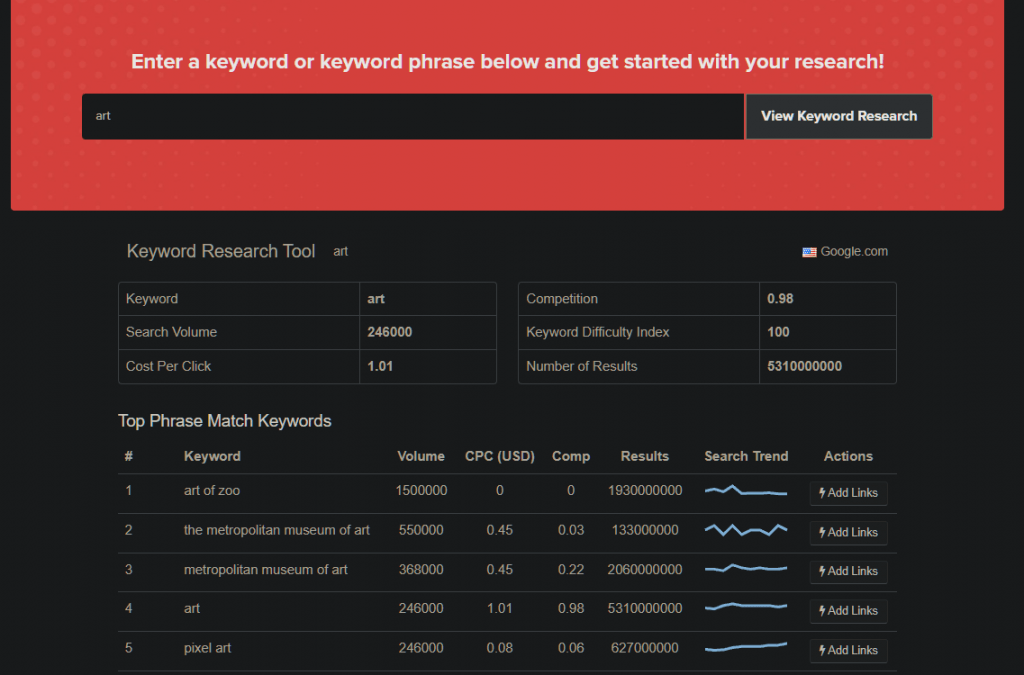
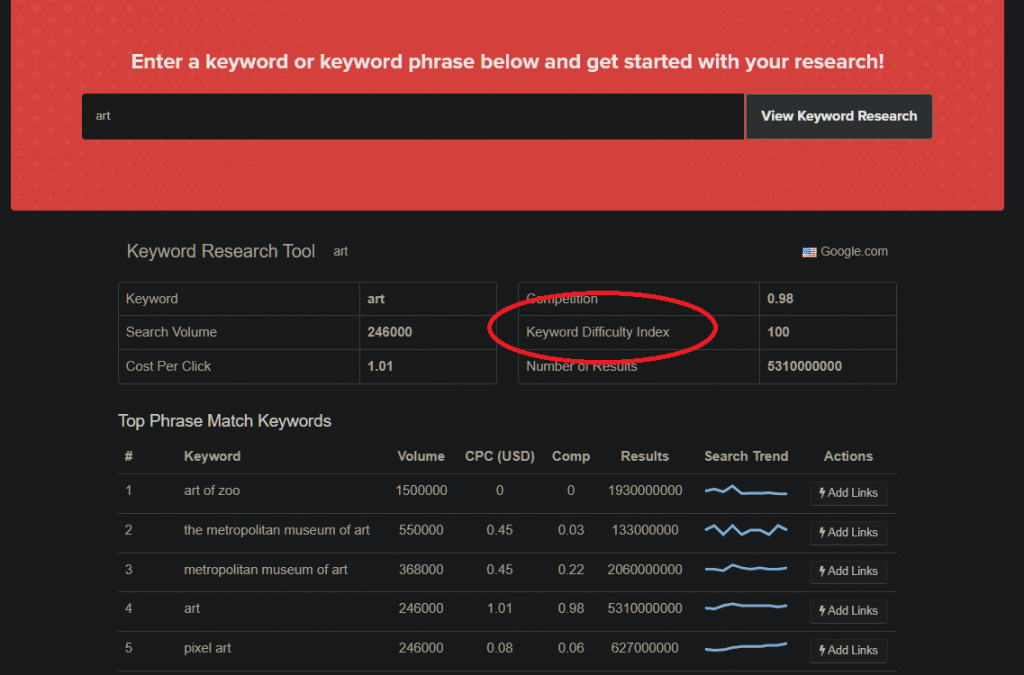
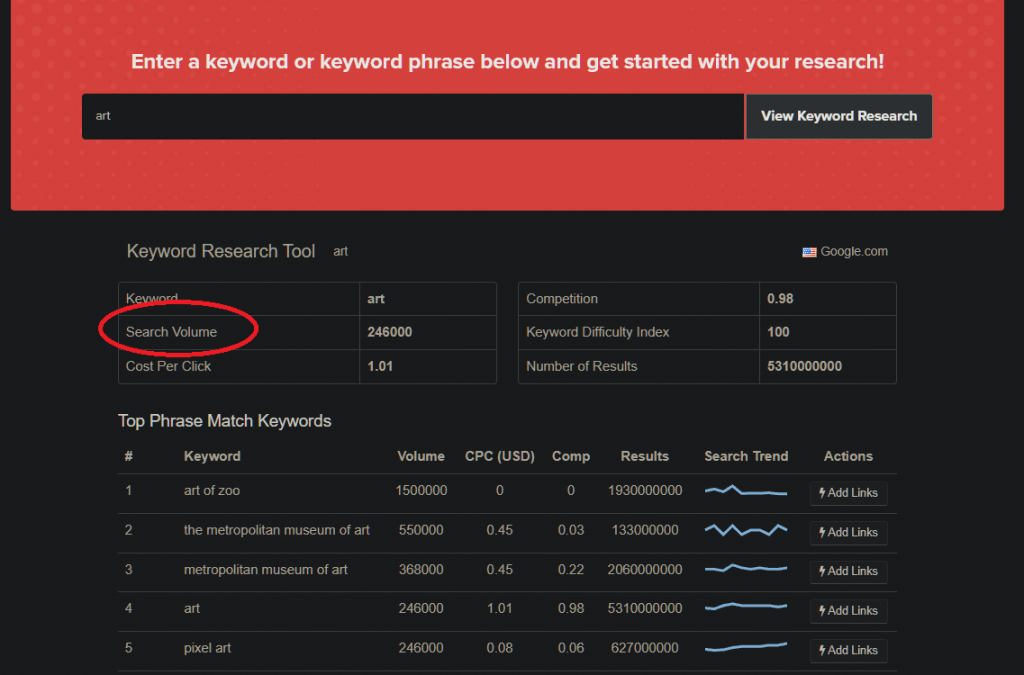
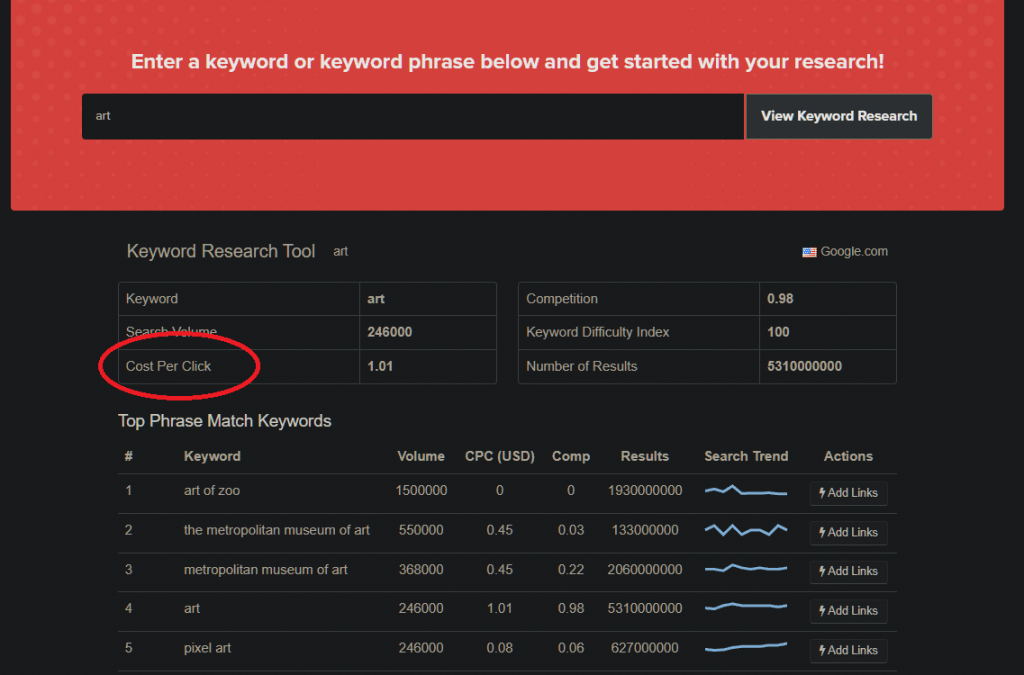
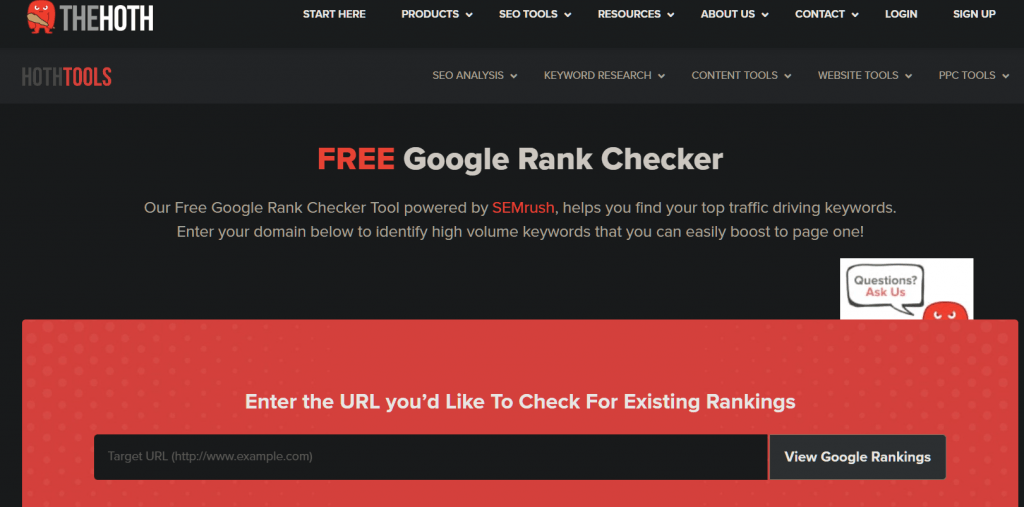
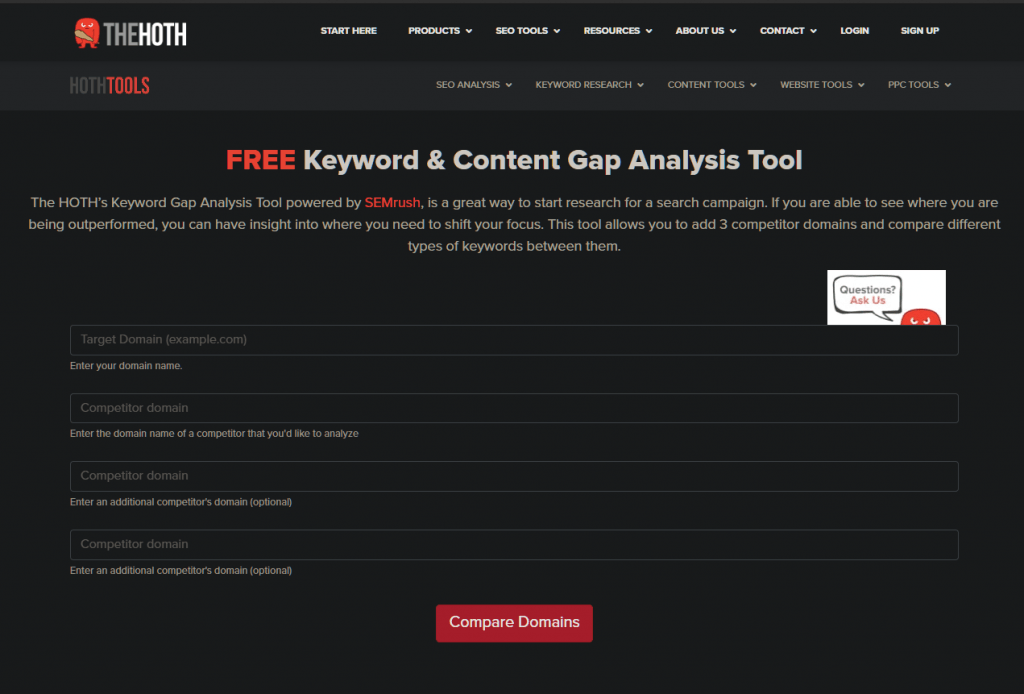

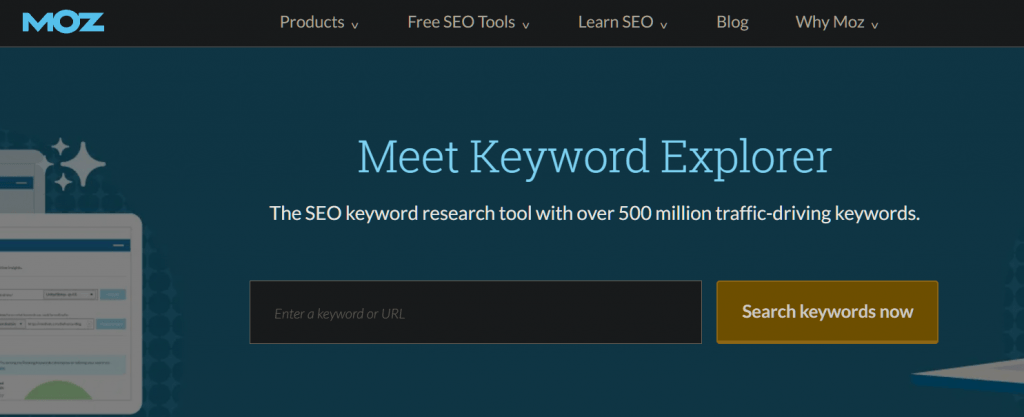
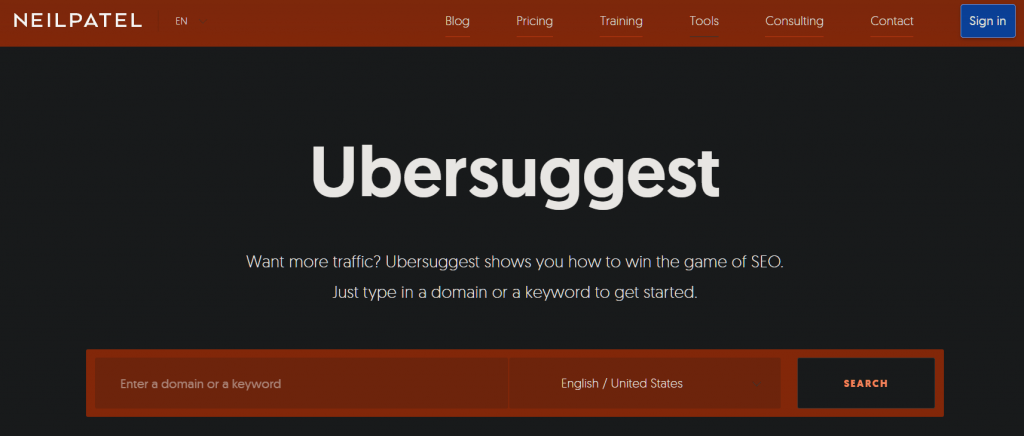
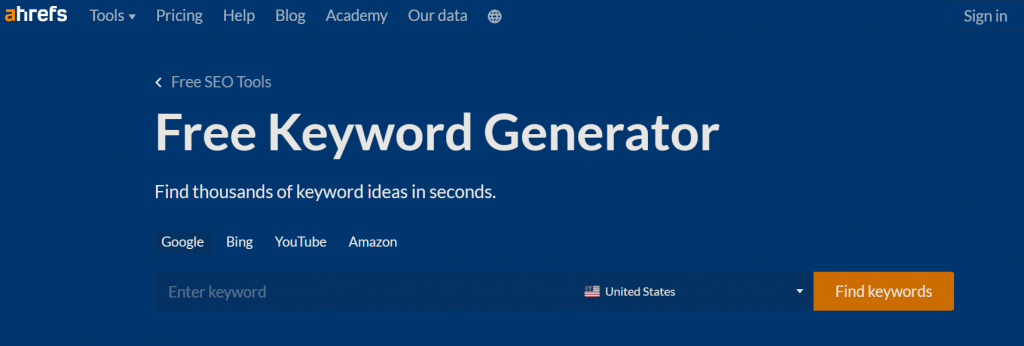
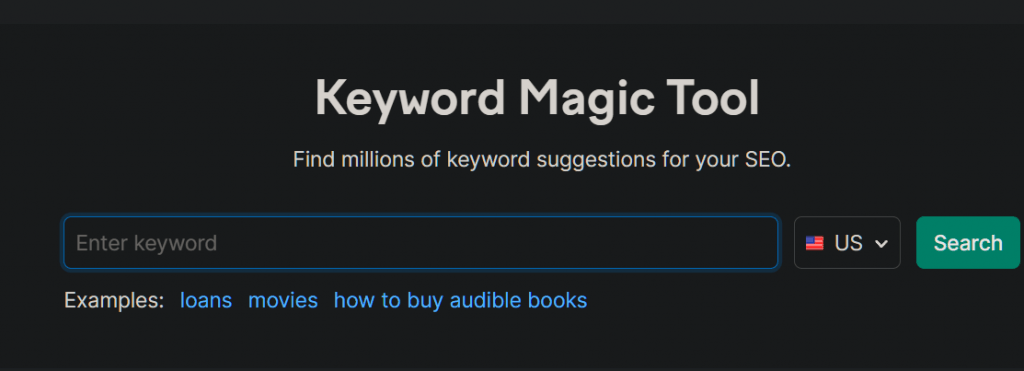
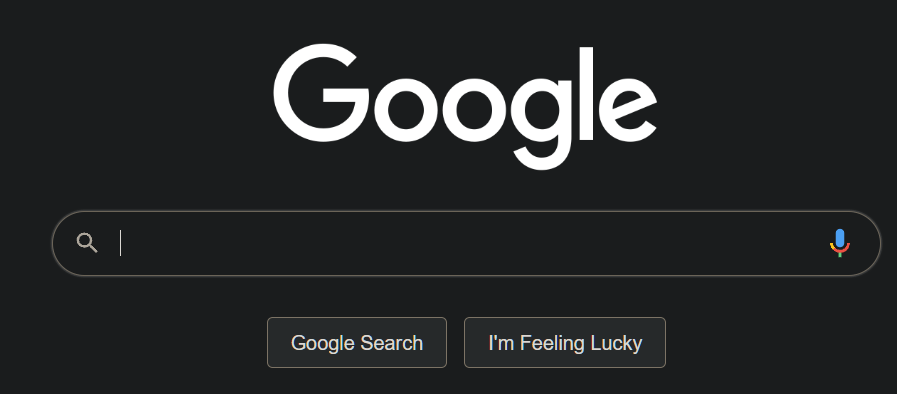


this video is bullshit
most Kws are adwords-based.
You have no fucking clue what you are doing, kid.
What did your mom teach you about that kind of language Frankie?
Indeed, Frankie …
My dear frankie, you need to wake up, I think you did not even watch the video to the end.
thank you for taking the time to share with us such a nice article.
Yes Frankie. Don’t be lazy. Learn how to speak proper English…
Great video SEMRush is an awesome tool but it’s pricey. I recently came across an even more thorough tool, a more precise tool (no averages) and best of all, you pay once and it’s still cheaper than one month at SEMRush.
We all have our tools and our affiliate links like SEMRush, Jaaxy, Keyword Keg or whatever you have you. I have tried them all but this gem seriously has outperformed anything I have put it on so many plains and it even updates constantly to stay ahead of the game and best of all, I only have to pay one time and it does the same as having several good paid tools like SEMRush, Ahrefs etc…
The absolute best 2 things are first off, I no longer have to keep dishing out monthly through tools to find what works best and paying a monthly or annual overhead. Lastly, it has given me better results in literally 6 hours on several occasions. I also can’t believe no one talks about it. Maybe that is why it is such an amazing little treasure to find.
Keeping looking and I am sure you will come across it soon enough, it’s a “powerful” tool to have in your online marketing toolbox.
OK Jair you got me. What tool are you referring to?
Can you tell me the name of the tool?
Same here?
Can you PM me the tool please.
thanks for sharing
I’m going to recommend the Hoth to everyone simply to spite Frank.
I think I would do the same way too! Frank needs some chill pill. Actually these article and video are very useful. I’ve been doing this a long time, minus using the Hoth in the process because I’m only subscribe to SEMrush, and it works perfectly fine. His method of gathering high relevance competitive keywords is a shortcut to the long process of old school keywords research and analysis.
yea, sweetheart you are right
Yes Indeed
Love you Frank xx Preach it!!!!
Does anyone else think that Frank is the Cat pictured slumped on the couch in the beginning of this video?
All kidding aside, this is yet another good piece of content from you guys. Appreciate the in depth look at all things SEO and link building.
Great video, very useful. Thanks.
It sure is a lazy keyword research approach. Nice post.
This Video Is Awesome! Is There any video that can teach my little frankie, “How To Speak In A Proper Manner”
Thanks
Karan
A little late to the game, but good video! I was already using semrush for different projects, but I now use it for my own!
What happens when a large aggregate is our biggest competition? Storage Depot has 32 locations throughout Texas, and our largest SEO competitor is something called sparefoot.com ~ which has about a bazillion urls, and takes out new ones everyday. It’s seemingly impossible for an individual entity like Storage Depot to compete. Take SpareFoot’s urls, add good old Public Storage’s website, and ….DANG! And somehow the boss thinks I can make Storage Depot’s SERP come up above? all of those?
Really? That’s possible? Ok Hoth-ers, let’s see this. Ya got the contact info. Let’s talk. 🙂
Man, you are working with a monster. Good luck with that. Maybe you could do some negative SEO 🙂
Hey Brad,
I am in sort of the same situation, has anyone responded to yu with anything constructive?
Lisa
Hey Lisa,
Can you submit a ticket with some details about your site & situation? We can help come up with a strategy for you.
you have to flip the script, forget the huge words like depot storage, look at your target audience. why people use storage companies? divorce, off to collage, selling their home, opening a business go at the key words from different angles use synonyms of your key words. and also run some ads on google I’m assuming your site is SEO friendly. do some back linking these guys at the hoth helped me in the past big time. good luck
Ray, that’s awesome, actionable advice- it’s the approach I would take/ recommend also. As Ray said, go after long tail keywords and user intent- that’s where you can compete. Also, I would suggest making local reviews a top priority. If your client does a great job and has a great reputation, you can leverage that to attract more visitors. You may not be able to dominate for “depot storage,” but you can target local search inquiries that come from Yelp or Google+ etc. That plus long tail KWs will be you best bet in my opinion.
Perhaps you don’t fight them on their turf, meaning you could probably get some good traffic from YouTube and using TubeBuddy. I’ve had good success with it and I’m in a very competitive niche too with competitors that have insane budgets for Google adwords. Take a different strategy if the one you’ve got now ain’t working. The other advantage to YouTube is the quality of audience versus other channels. Your prospects are looking for you 🙂
Frankie needs anger management. He probably kicks kittens, too.
Frankie needs his mouth washed out.
Great video!
Hi,
The video looks awesome but when I tried it after signing up, I get a Not Authorized under the green box instead of the SEMRush tool. Did I miss a step somewhere?
Hey Daniel,
Thanks for letting us know – It looks like it’s working for me currently, hopefully it was a temporary bug. If it continues, please let us know by hitting the support widget at the bottom!
Question: If we use your free keyword search tool for our clients, how do we know you’re not grabbing that client url and contacting them directly to get their business? I’m not saying you are doing this but this kind of thing happens ALL the time.
thx
Hi Gee, this is certainly not the case. We only require an email address to be inputted to use our free tools and this email is then added to our email list. We do NOT capture any URLs that are submitted through our free tools.
good articles and video
A great video. It gave me an “aha” moment! Now I can get down to business. Hey…BTW what is the story behind the name? TheHoth sure would like to know.
Stands for Hittem Over The Head, as in to be bludgeoned with awesomeness. To be amazed at the product, service, etc. The goal was initially to become the Zappos of SEO.
There are some good techniques in the video but overall it is not a great way to pursue keyword research at all. If it is for your own site do whatever you want, but if somebody is paying you money for SEO and this video sounded good to you… you probably should not be doing SEO for them.
Hey Chris, Thanks for the feedback – Would you elaborate on what you would suggest / not suggest from this video?
Check this one: http://secockpit.com/ for keyword research. Quite comprehensive.
Lol oh Frankie Frankie…
Good help especially finding competitor keywords that rank well. Mmm some good software for this I have…but the ideas are solid.. still links required perhaps tiered which is work no matter how you deal with it.
great thanks 🙂
Great Video Hoth, nice.
Loving the Frankie vibes, we provide Social Media training, perhaps Frankie would like t contact me for some, discount on first lesson!!
The tool SEMrush in your software, is this USA based or for Worldwide? As I am seeing different keyword rankings for a site- tillrollsinternational.com using SEMRush as I do for SEOPowersuite using UK search engines (Google.co.uk).
Stuart
There is a selector box to the right of the search box that has a little flag. There you can change it to whatever country you’d like. Also, if you’re searching for a new domain, there is a dropdown to choose the country you’d like to search in.
Cheers!
Hilarious meme — my kind of style baha.
I love SEMRUSH. I also use Spyfu’s SEO dashboard, AWR, and Rank Tracker from SEO Power Suite. Hey, Hittem Over The Head, what’s your favorite link strategy for getting those page 2 rankings up to page 1 in a high competition niche?
Oh and I love you, Frankie.
We use an SEMrush Guru account. Love the branded reports but often times I find the search volume data doesn’t line up perfectly with the data from Google’s Keyword Tool.
Two tools very important for SEO. Even the Keyword Research is the most dificult task (im my own experience) and here is a piece of cake. Thanks!
I an Seo(search engine optimization) expert. I strongly recommend that semrush is very good tool and if someone is initial stage for seo and don’t know anymore about seo than semrush is very good tool for them. Also this is good job by thehoth.com. thanks
Quick an easy keyword research! I’ve isolated a few keywords on page 3, nothing on page 2 yet. Guess it’s time to start writing some keyword targeted content! Hate writing though. 🙁
An awesome video. It gave me an “aha” minute! Presently I can get serious. Hello… BTW what is the story behind the name? TheHoth beyond any doubt might want to know.
It’s an acronym for Hittem Over The Head: https://www.thehoth.com/about/
Great information in your post. It’s crazy how many different KW tools are out there and I understand how people get lazy/crazy. I like Ahrefs myself. They did a good update recently.
Ahrefs.com is the bomb!
There is a selector box to the right of the search box that has a little flag. There you can change it to whatever country you’d like.
Selector box has a little flag can sekect the country u like
This awesome video is so helpful. In fact, after seeing this video, I made a huge list of competitors keyword. Actually, Semrush is showing only top hundred keyword list. The list could have been more. I am analyzing the list. I am a regular customer with HOTH.
I think SEMrush has to increase the keyword database more and more.
Great job here. I love SEMRush it’s a great tool for finding keywords that you’re ranking for already and your competitors keywords and backlinks 😉
Frankie got trolled . Great article for keyword research though
When I do the domain search it just comes up with domain search results. Even when I use a big brand store. I don’t get key word results
Can you clarify your question? Are you using our Search Engine Rankings tool?
I am using HOTH guest post package for ranking high difficulty keywords from last 2 years , This video is really helpful for me.
Thought this video was well worth the 3 minutes it took to play. I am working in lots of areas and it just makes sense. I watch keywords and look for ones that are close to first page. Good job Hoth.
I like how your emails always come just before Search Engine Watch. Lol, Strategy indeed!
We focus on SEO for Shopify ecommerce stores. One of the quickest and most immediately valuable boosts we do for many clients is exactly what you talked about: finding long-tail keywords that these guys rank for already, and building links to push them up to Page 1.
Since they’re already ranking, it’s a relatively easy task, yet moving from page 2 to Page 1 is often a big win in terms of traffic & sales.
Good stuff!
Is this video an outdated one, because there is no Keyword Research link on the Keyword Research page. I had to go to Tools then Keyword Research but it didn’t take me to SEMRush rather to Hoth Keyword Research page.
Yep, we put it under “tools” since we more tools inside our portal. You can also get it here: https://www.thehoth.com/google-keyword-planner/
What is the difference between Volume and Results in the Keyword search?
Also, what does 1.0 mean in competition?
thanks
Results = number of pages in the SEMRush index for that keyowrd
Volume = average monthly search volume
Comp = on a 0 – 1 scale, avg PPC competition for the keyword
This was really helpful, I had already been tinkering with the KW research tool but this provides some additionally solid insight.
For newer sites, does it make sense to attack a lower volume search term and one with lower competition score to allow for faster ranking? Would this effectively be cheaper to target with ads despite the smaller audience, and if so, would the effect be any different on ranking for the KW?
Big fan of The Hoth blog articles, thanks for the help.
Right, if your website is just starting you can go after lower comp keywords to get faster results.
I tried logging in to follow your method, but my Tools view does not look the same. I can’t look at only page 2 results. It just shows me a summary of keyword performance data for the Top 100 results for the domain. I’m in the search engine rankings tool
Hey, that should be good and give you a lot of data. You can use the tool here: https://www.thehoth.com/search-engine-rankings/
nice video. only thing I am missing is the keyword difficulty. before I build a niche site and spend countless hours building content I’d want to know if I even have the remotest chance to rank or not.
but great anyhow. and it is really free?
We like to check keyword difficulty with kwfinder.com or ahrefs.com
Awesome Video article for keyword research
Frankie, this is right time. never too late for learning a something good in life.
Best Post
a great video !
A lot of Frankie-related comments here. are you working for the Hoth? 😀
Nice video. Clear and straight. ahrefs + Semrush keyword magic tool <3
This is really a great video to start keyword research for a lazy bee like me.
Thanks
I tried logging in to follow your method, but my Tools view does not look the same. I can’t look at only page 2 results. It just shows me a summary of keyword performance data for the Top 100 results for the domain. I’m in the search engine rankings tool
I have used the keyword research tool that the Hoth offers on it’s control panel and I have been fortunate to have found major keywords that has ranked my website in the top 5 on 1st page of Google.
Thank you all from Hoth.
nice video and clear concepts
Thanks for the Keyword Research Tool
Am looking for the tool since a while , today i found the keyword research tool on Hoth , Keep Building more Tools
Thanks again Hoth
very nice post i like it thanks sir
I have blog readfirst.tech it is well designed and well setuped but the organic traffic is not increasing and sometimes no one visits means zero plz plz sir help me
Hi! There are a LOT of different factors that would affect whether or not your organic traffic is increasing. One mistake a lot of people make is relying on organic traffic from search alone, or making content and assuming that it will rank. If you start to learn more about link building, you’ll be able to come up with a strategy that fits your needs. It would take too long to go into it here, but this article on our site provides a good overview of link building to get you started.
Am into health niche am a bit confused can someone pls help to make me understand better thanks
What specifically were you confused about, Kenneth?
I have gone through the video and I have a free account on semrush but cant see the type of dashboard that appears on your end. i don’t have a keyword research on my end so is there a problem or what should I do?
There are some free keyword research tools available out there. We have some on our website: thehoth.com/seo-tools/
Awesome video! Great job!
Thanks for the kind words on the video!
Glad you found this video useful.
Helpful at least to my lazy fella 🙂
Awesome video! Good job!
Thank for this information
Glad you liked it Pooja! Thanks!
Thanks for uploading this video. I really appreciate your time and effort for doing this.
You’re welcome, thanks for watching!
Well, I came here to rewind some stuff which slept inside my lazy mind, but found some manners classes in the comments.
First of all kudos to Hothadmin for not deleting comments and strongly and patiently replying.
This awesome video is so helpful. In fact, after seeing this video, I made a huge list of competitors keyword. Actually, Semrush is showing only top hundred keyword list. The list could have been more. I am analyzing the list. I am a regular customer with HOTH.
I think SEMrush has to increase the keyword database more and more.
Yes, you’re right. Have you tried using Ahrefs? It’s another great tool.
Awesome !
I love reading every mail sent to me by Hoth. Thanks for the knowledge.
You’re very welcome Nasreen, thanks for reading!
The link to “Tools > Keyword Research in your dashboard” does not work. After I create the free account, none of the links work.
Hey Robert, try refreshing your browser’s cookies or try another browser, and if it still doesn’t work, please submit a ticket with our support department and they’ll make sure you can access them.
Well, SEMrush is good, but not that good lol. Their index is quite small and I’ve seen a lot of keywords missing in their standard reporting. But for quick a dirty ideas research – sure it’ll do.
Could be an advantage in using a combination of tools, that being said we love Ahrefs and might use it more than SEMrush nowadays.
help me for dofollow backlinks Sir
Nice Sirr
Can You help me for dofollow backlinks
I have been enjoying hoth services for a while now,
their tools and their tutorial are quite amasing
thank you sir for sharing this knowledge this is a great article.
Use full for me Thanks to Clayton Johnson.
You save my time With the tips
Wow…I love this article, so helpful to me.Thanks for sharing
Great video – In section 3 “Find easy keywords” – How do you ascertain that the keyword is easy to rank for?
This can be a variety of things! The top 2 to look for are KD (keyword difficulty in Ahrefs) and CPC (cost-per-click).
In the last section about guitar keywords, you say that you find several excellent keywords with big volume but low competition, but you do not mention how you know they are easy to rank for, can you elaborate? Thanks
Great information in your post. I really appreciate your writing style. You explained things really well. Keep sharing goodness with your articles 🙂
Thank you so much. I was getting so frustrated with google keyword planner and the sheer difficulty of keyword research as I don’t have a budget for tools yet. This is so funny let me tel you : I typed into google search “google keyword planner is f*ck&ng useless”, but with the swear word in full correct spelling and thereby found this article. My frustration drove me so hard. Thanks Clayton. I am sure to use many of The Hoth’s services as soon as I gain some traction on the income side. You guys will get met there.
This is your Thehoth.com/keywordresearch tool is showing 100% true results.
Amazing Valuable Information..
Great video from the hoth, very insightful it is.
Great content! : )
In Hoth keyword research tool, what is the Keyword Difficulty Index metric, and what is the competition metric?
And what is the difference between the two? I am very confused with these two metrics. pls help if you know the answers
Thanks.
Keyword research is the main pillar of optimization, Thank you for explanation.
Great information, refreshing approach to keyword research videos which all tend to be the same!
Such a detailed article and the way this information is provided is just the next level. I loved this article. Keep going.
Outstanding video article for keyword research.
great article and very informative content
great article and very informative blog content
Such a detailed article and the way this information is provided is just the next level. I loved this article. Keep going.
Crafting high-converting landing pages is a crucial component of any successful PPC campaign.
nice blog
thanks for sharing
nice blog
Fantastic article, thank you
Very nice post. Thanks
Keyword research cant be done within 10 minutes.
It needs great research amd then only its worth ranking.
thank you for taking the time to share with us such a nice article.
Very Nice Article. Thank You!
thank you for taking the time to share with us such a nice article.
Excellent information on your Article, thank you for taking the time to share with us such a nice article
Excellent information on your Article, thank you for taking the time to share with us such a nice article. It help me a lot.
Excellent information on your Article, thank you for taking the time to share with us such a nice article. It help me a lot.